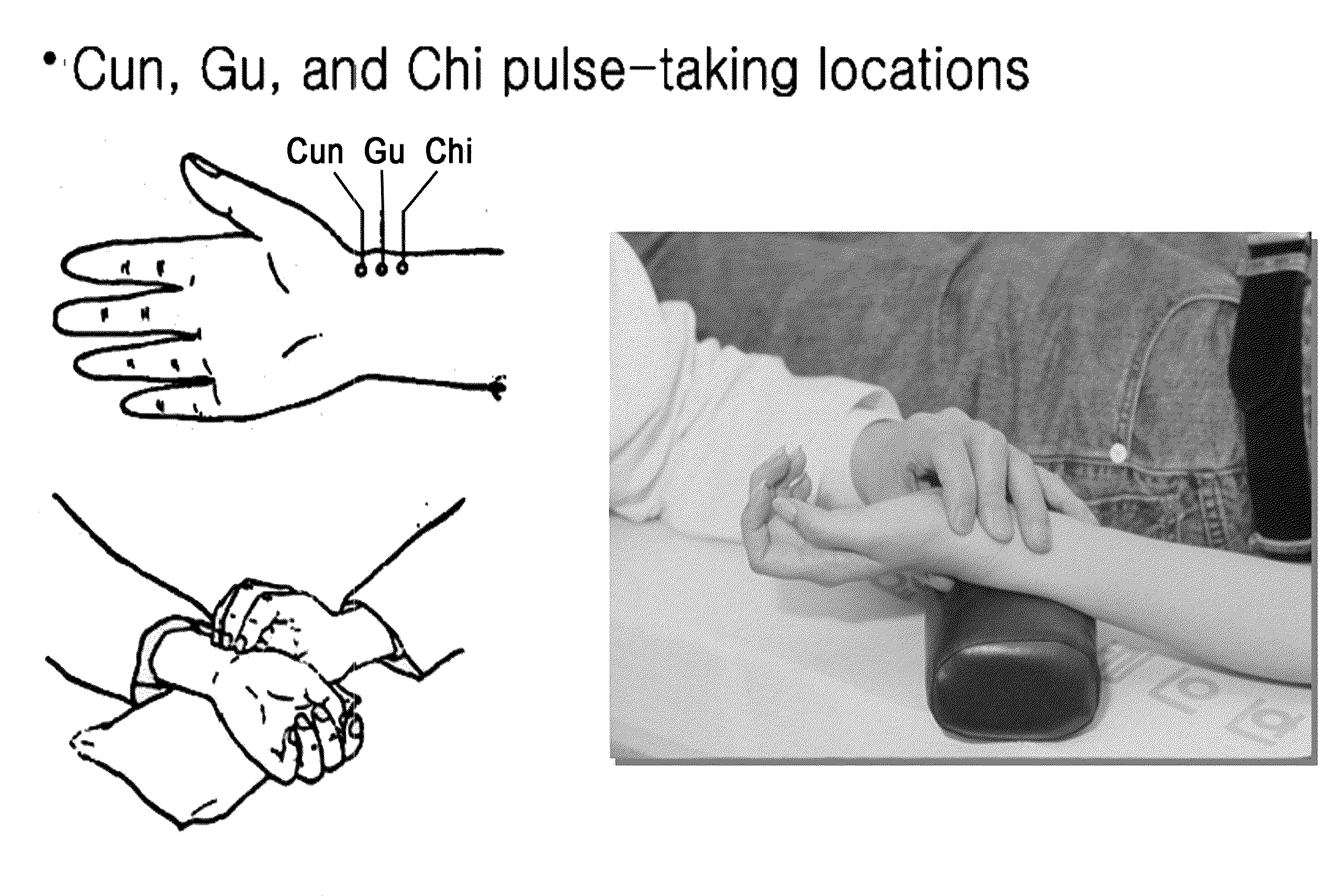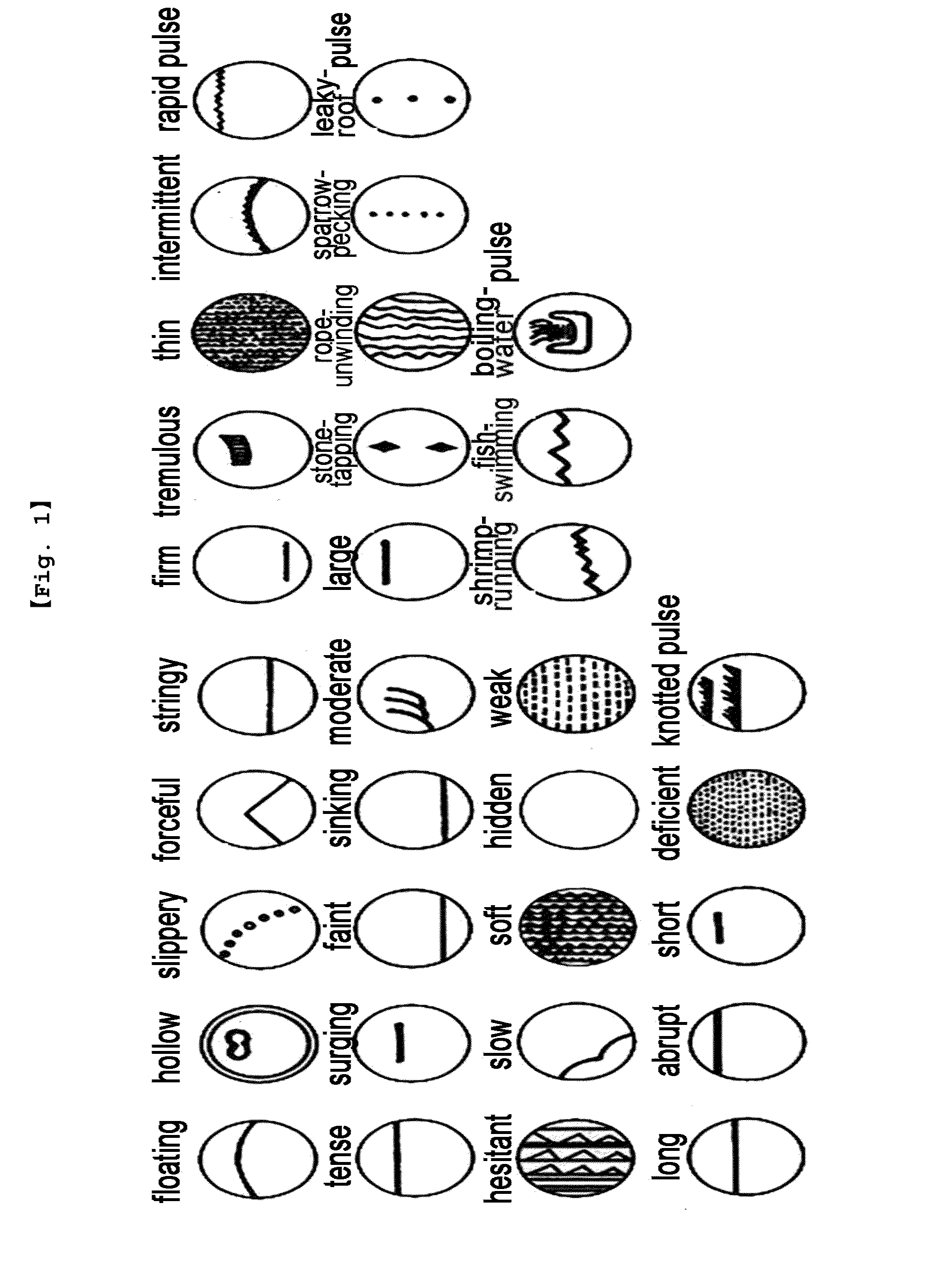Consequently, pulse conditions that have been used since the age when there were no measuring instruments have been handed down orally and have been instructed through experience, and thus have obscure termination criteria and are difficult to standardize (refer to FIG. 1).
However, when a human directly performs
pulse diagnosis, an examinee's pulse condition is determined depending entirely on the examiner's subjective senses and experiences, so that diagnosis results may vary with the examiner and the reliability of diagnosis may be reduced.
Meanwhile, most previously developed pulse diagnotic
pulse taking devices provide bio-impedance measurement results, obtained simply through piezoelectric sensors or the like, in the form of an output screen without bibliographical or clinical considerations with regard to pulse conditions used differently for respective purposes, respective preferences, respective symptoms and respective diseases, and thus it is impossible in practice to analyze an examinee's pulse diagnotic information, measured at a pulse-taking location, within the pulse diagnotic systems, therefore the pulse diagnotic information is of significance only as a reference that is used before an actual traditional oriental doctor's
clinical diagnosis.
More particularly, the conventional
pulse taking devices have been developed with an emphasis on the improvement of the performance of a pulse-taking sensor and a pressing unit, there is a limitation in that it is impossible to make an automatic diagnosis on an examinee's pulse condition within a pulse diagnotic system using such a
pulse taking device or pulse taking device, even though the pulse diagnotic system is combined with a 3-
dimensional analysis technique for pulse condition information.
However, when a pulse-taking posture is naturally assumed, the distance between the pad of the
index finger and the pad of the
ring finger is about 26 mm according to measured data, so that the distance forms a range within which a pulse cannot be taken using a traditional three-finger pulse diagnotic method.
However, the pulse taking device, designed as described above, has a problem in that the measurement process must be repeated because there is a strong possibility that pulse diagnotic information will be collected at pulse-taking locations that do not coincide with the concept of the Cun, Gu and Chi pulse-taking locations described in the original text, and thus it will not be possible to acquire accurate and reliable results in the actual process of measuring pulse condition information.
Moreover, pulse diagnotic analytic algorithms for pulse condition analysis, which are provided in either conventional pulse diagnotic devices or pulse taking devices, do not provide highly reliable pulse diagnotic analysis results because they have not been subjected to a process of designing output variables based on the physical consideration of the definitions of pulse conditions in light of traditional oriental
medicine and a process of performing quantification based on clinical data.
As seen from FIGS. 6a and 6b, the conventional pulse diagnotic systems do not provide sufficient analysis criteria for examinees' pulse condition information (for example, measured pulse pressures) collected by pulse diagnotic devices, that is, a clear basis for pulse condition diagnosis through the application of quantified output variables and determination logic based on the variables.
That is, since it is difficult to carry out systematic research through cooperation between experts in related fields, such as traditional oriental
medicine experts and mechanical engineers, due to the special circumstances of the development of pulse diagnotic devices and pulse taking devices, it is true that there exists an inherent limitation, in which consideration in the light of traditional oriental medicine and the design and quantification of output variables based on clinical data, which are requirements essential for the design and improvement of the performance of pulse diagnotic devices and pulse diagnotic systems, are neglected.
The conventional pulse diagnotic devices and pulse diagnotic systems based on the diagnotic algorithms, which are not based on based on the physical consideration of the definitions of pulse conditions in light of traditional oriental medicine and clinical data, as described above, have limitations in that the utility thereof is very low from the actual clinical point of view and the reliability thereof is very low from the point of view of the objectivity and reproducibility of pulse taking results diagnosis.
 Login to View More
Login to View More  Login to View More
Login to View More 


